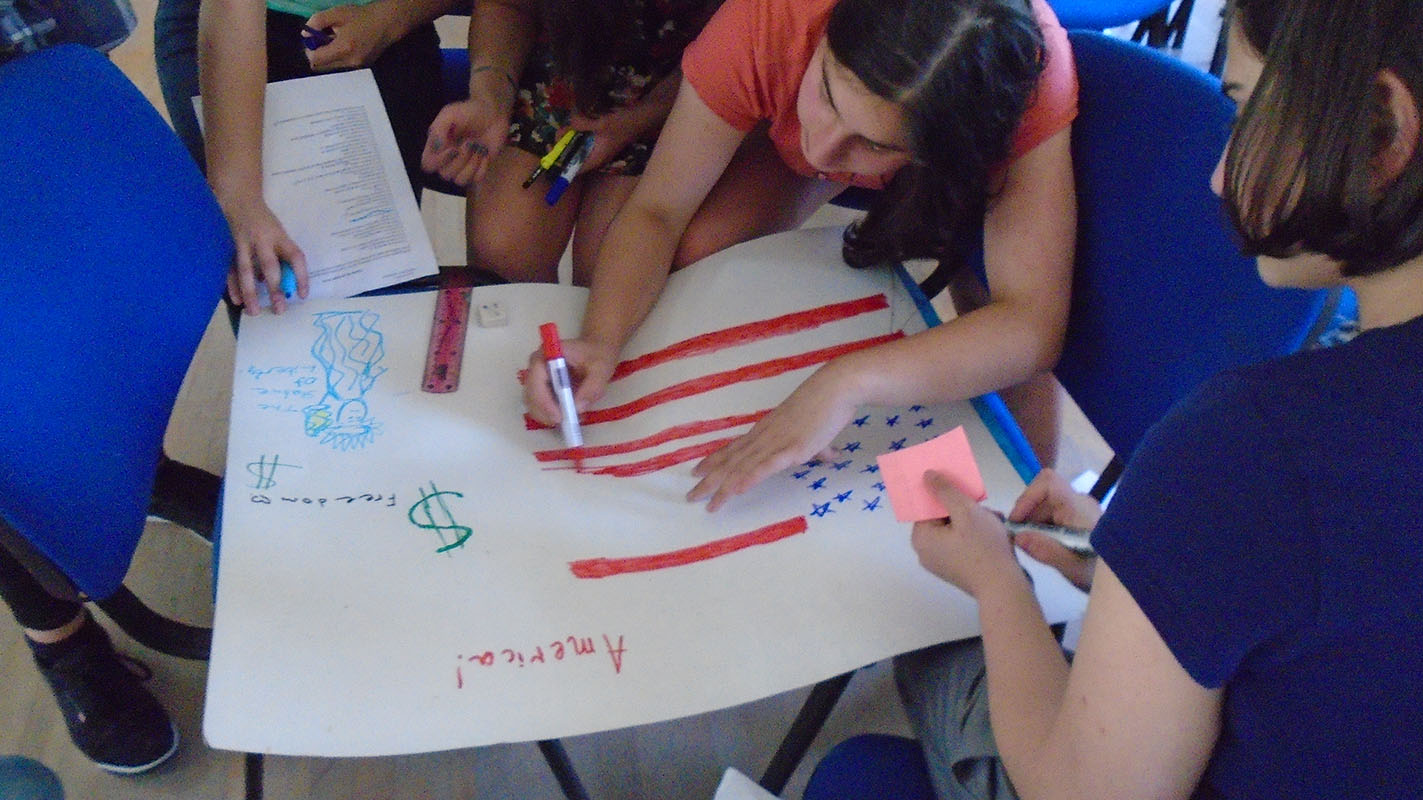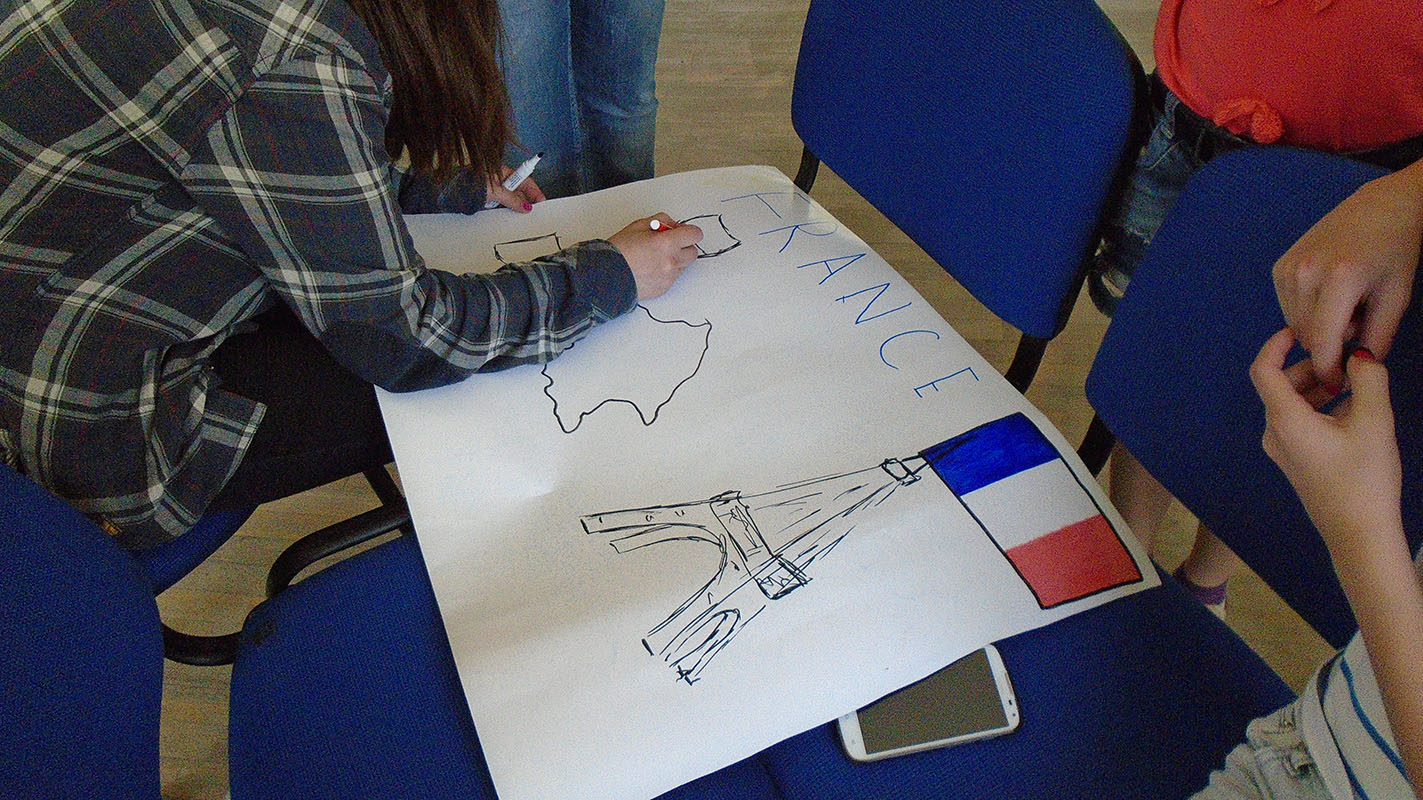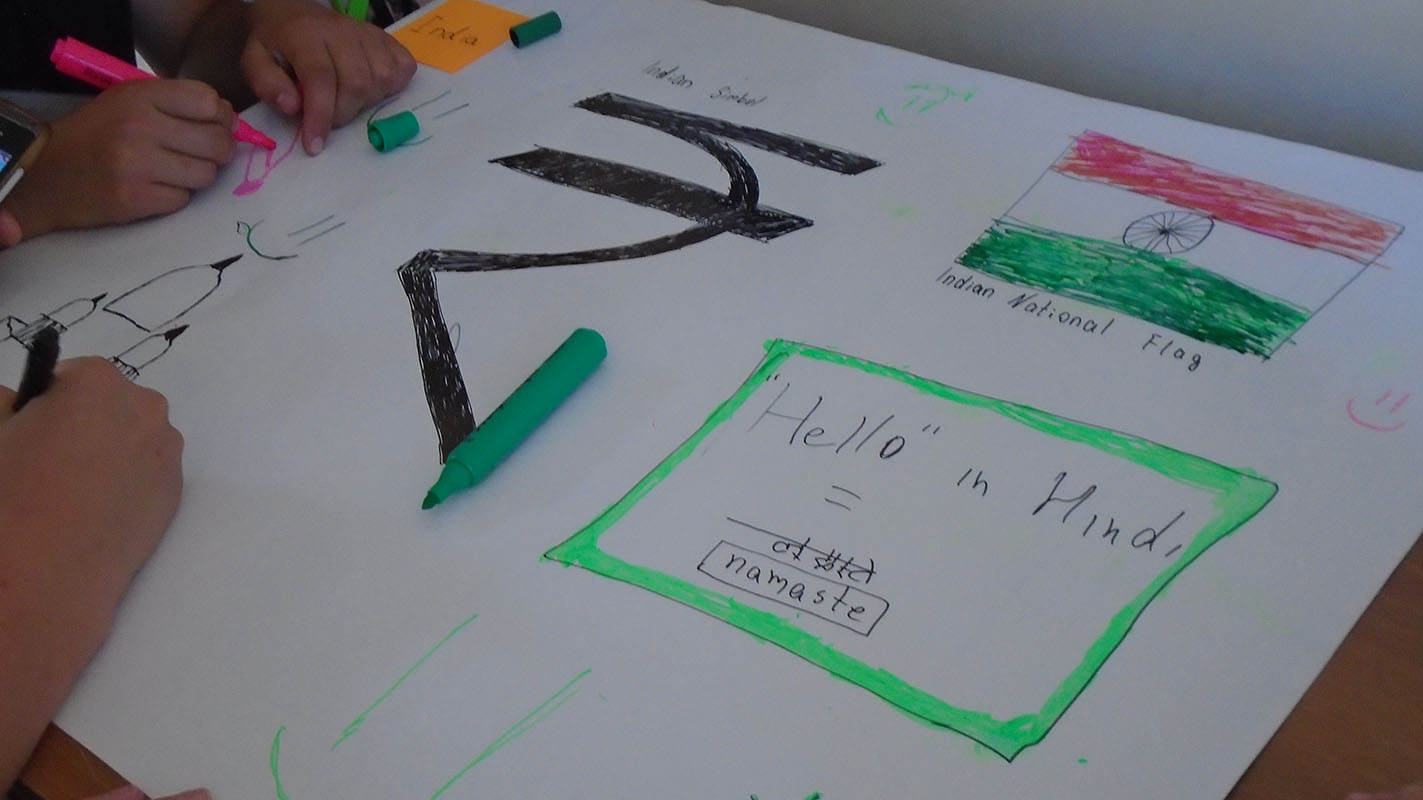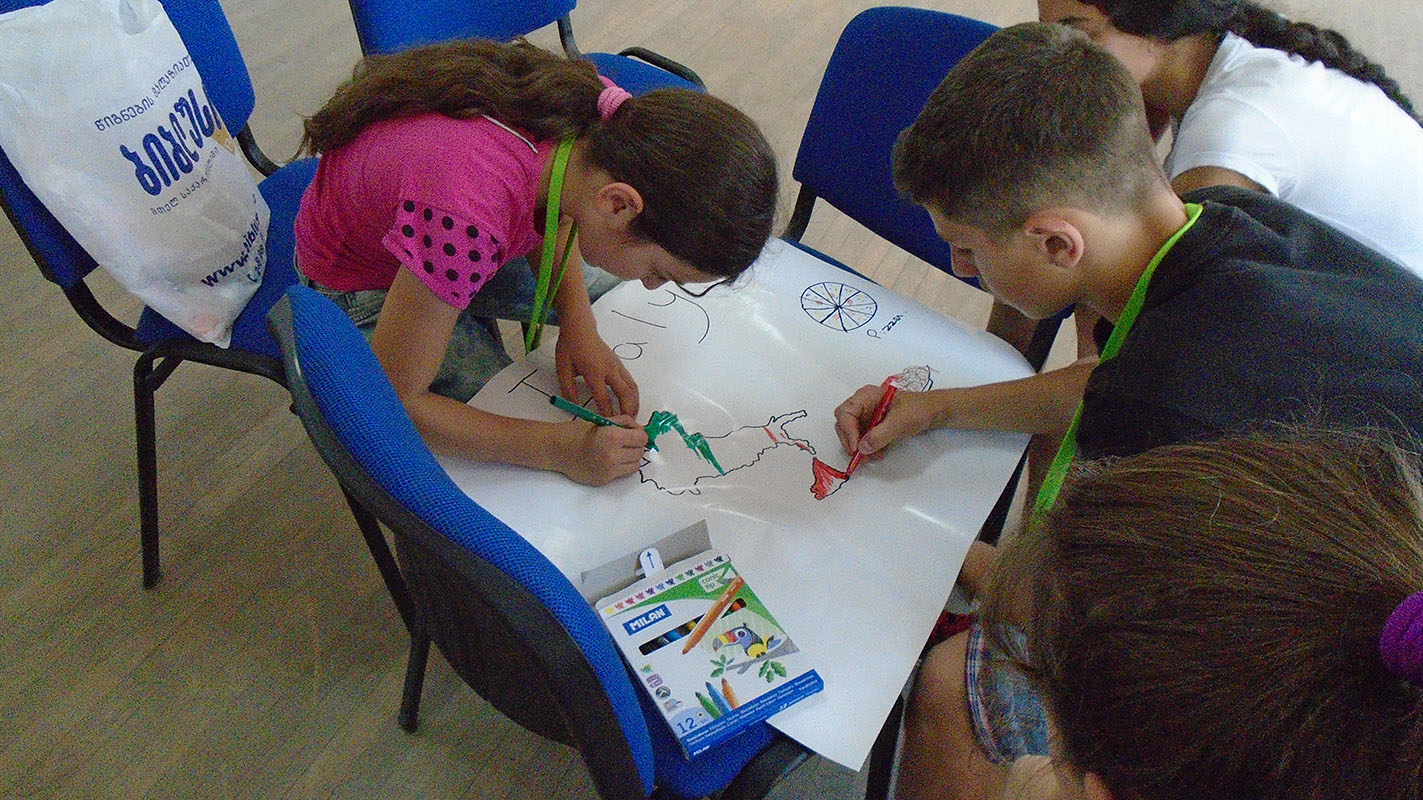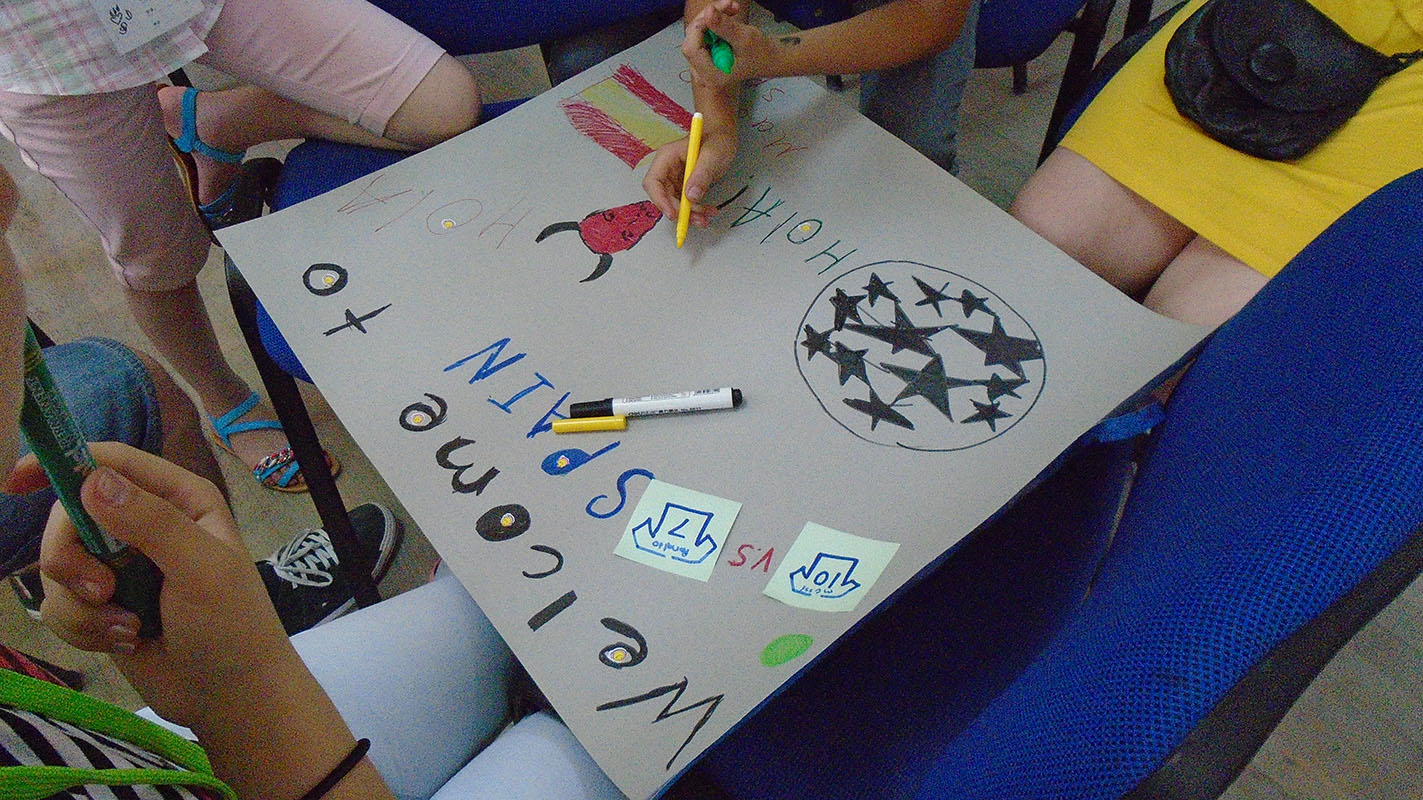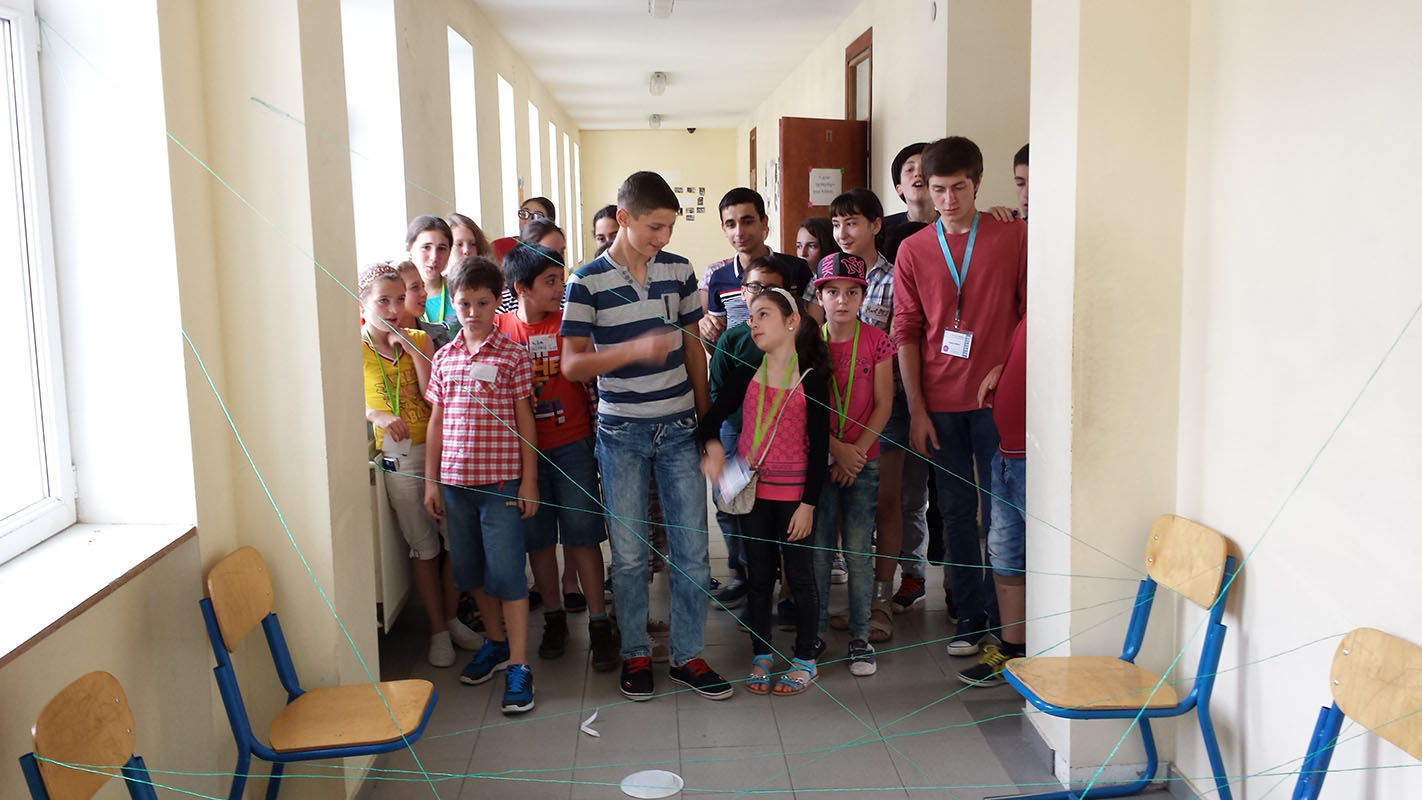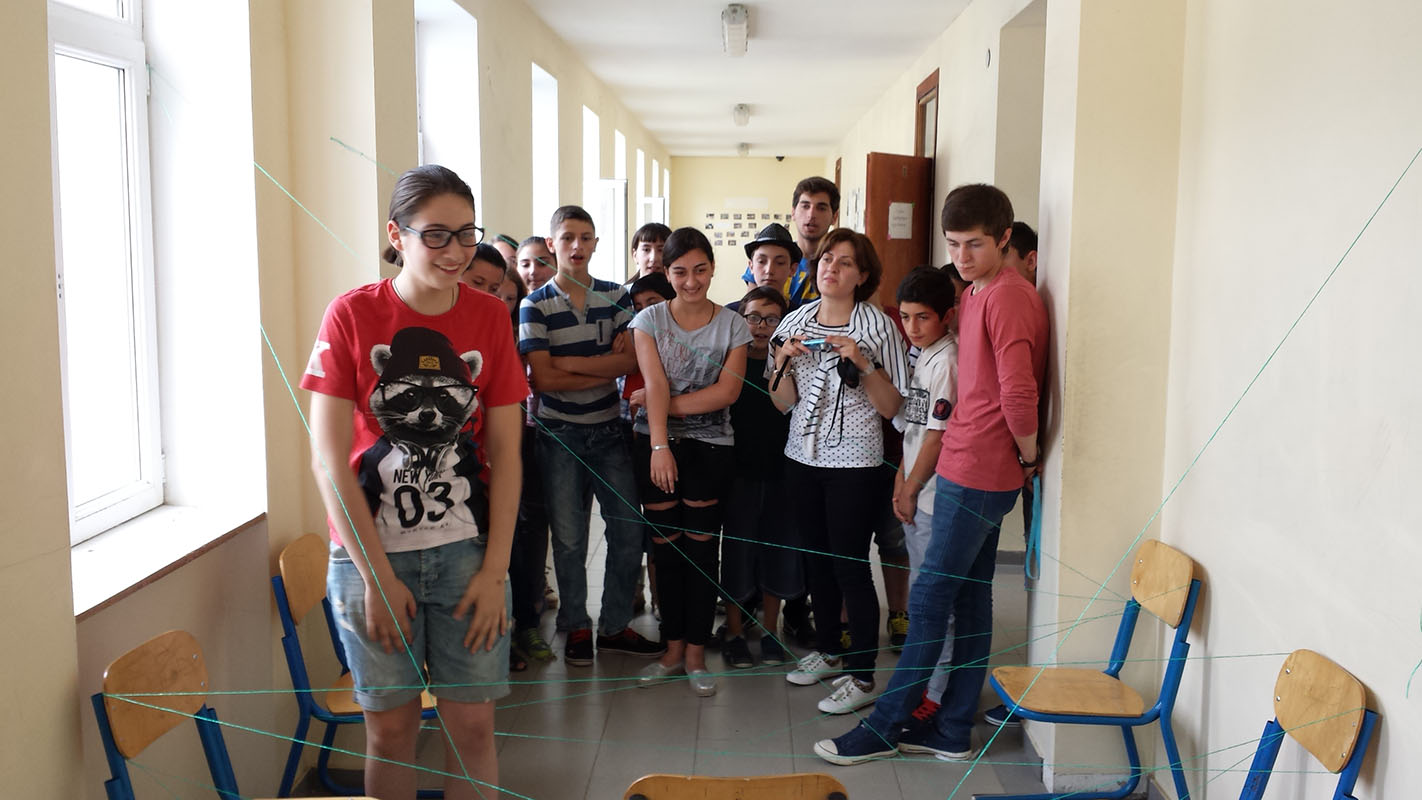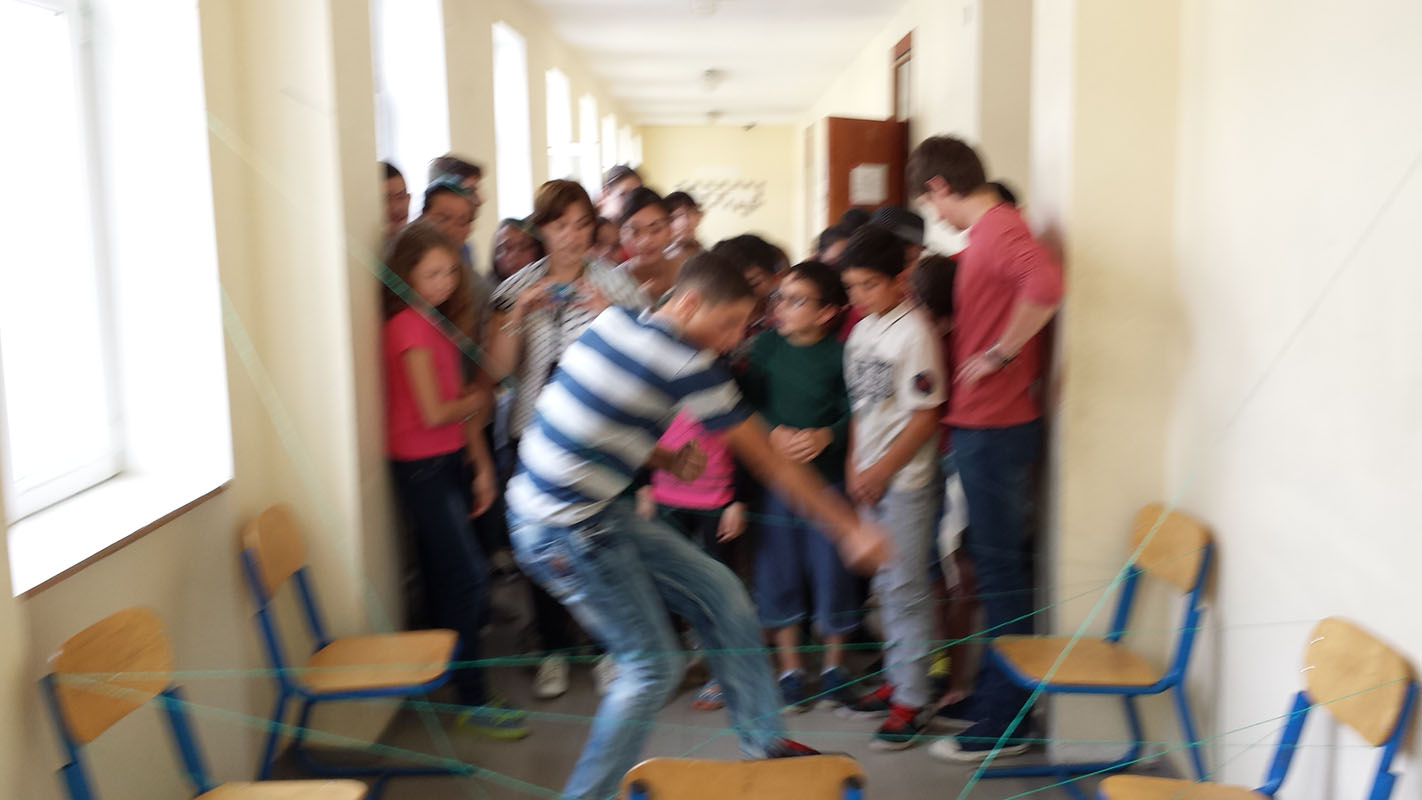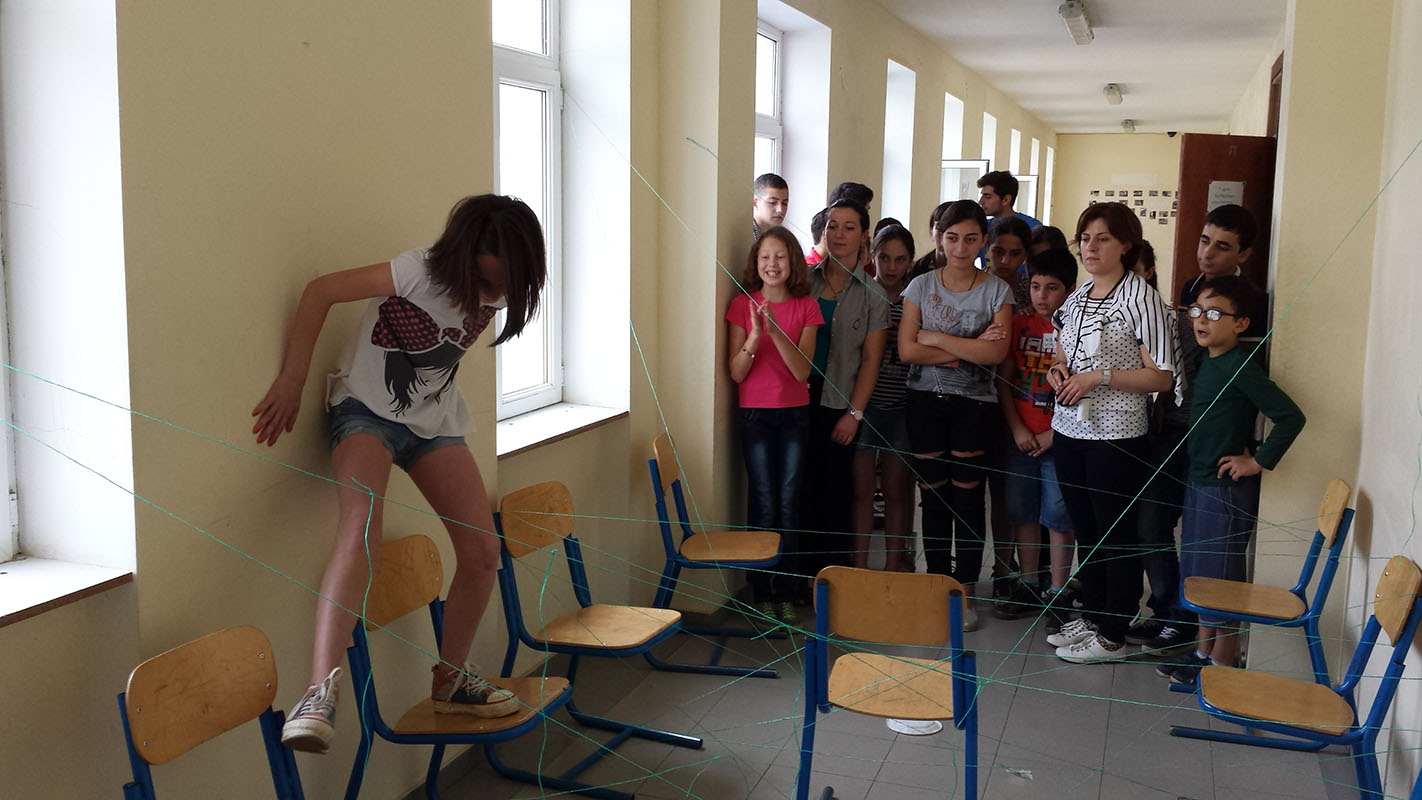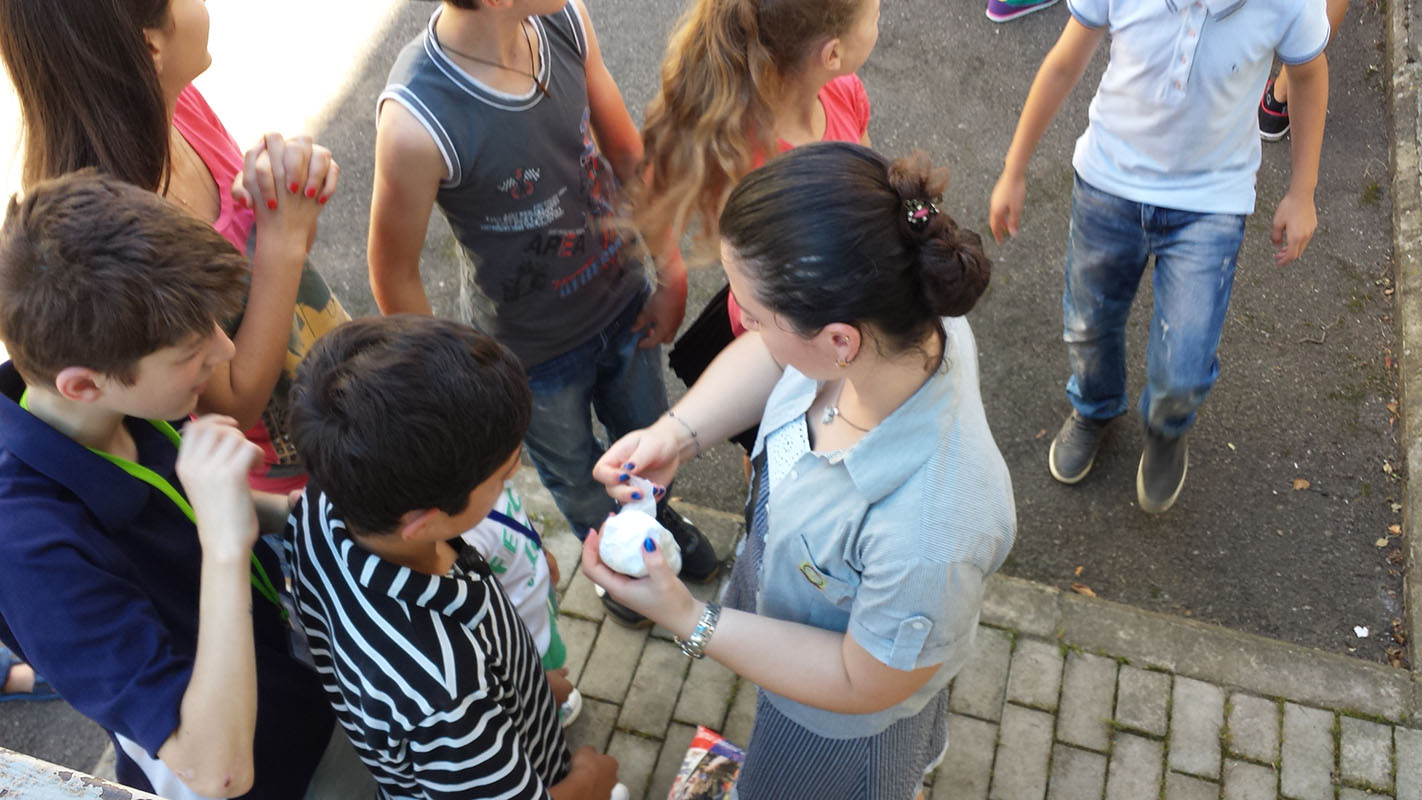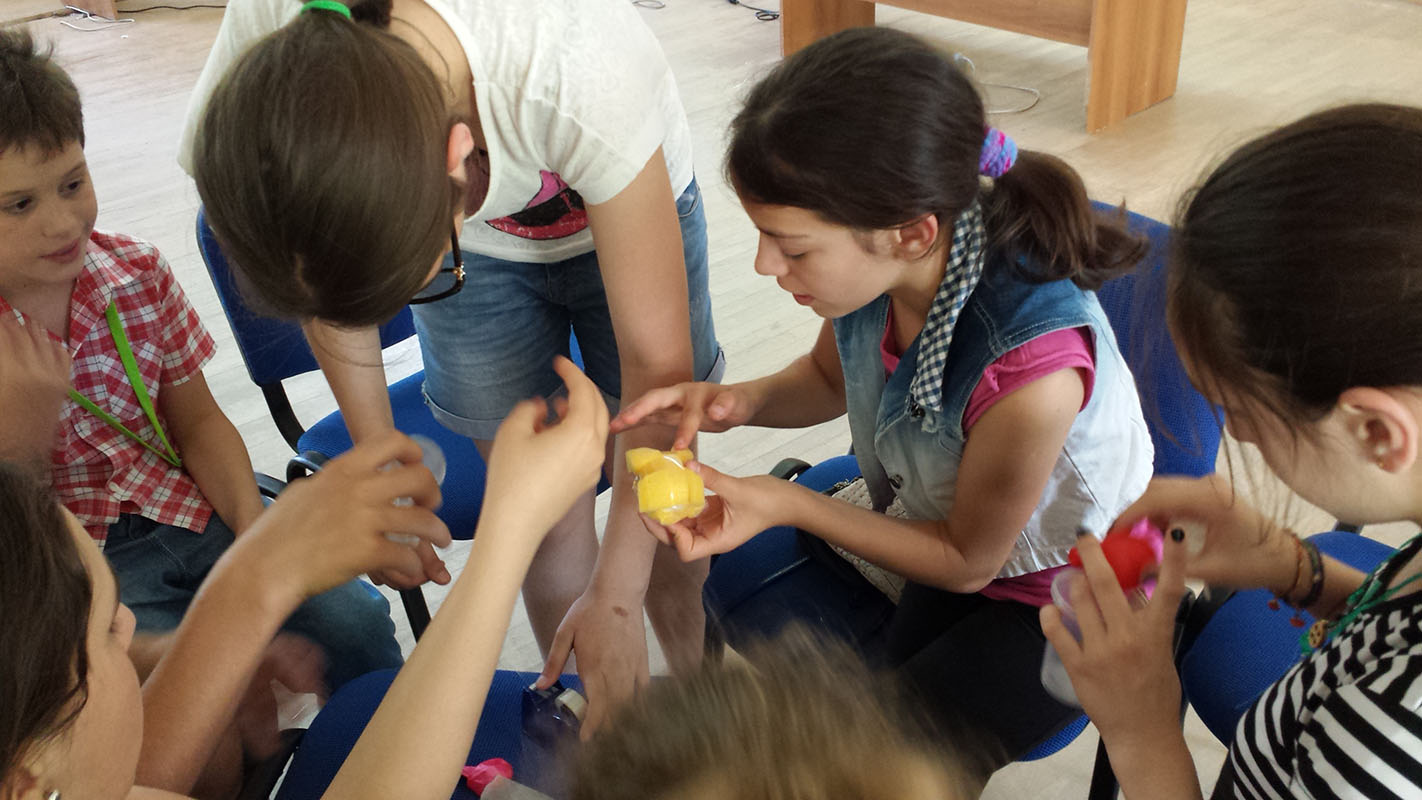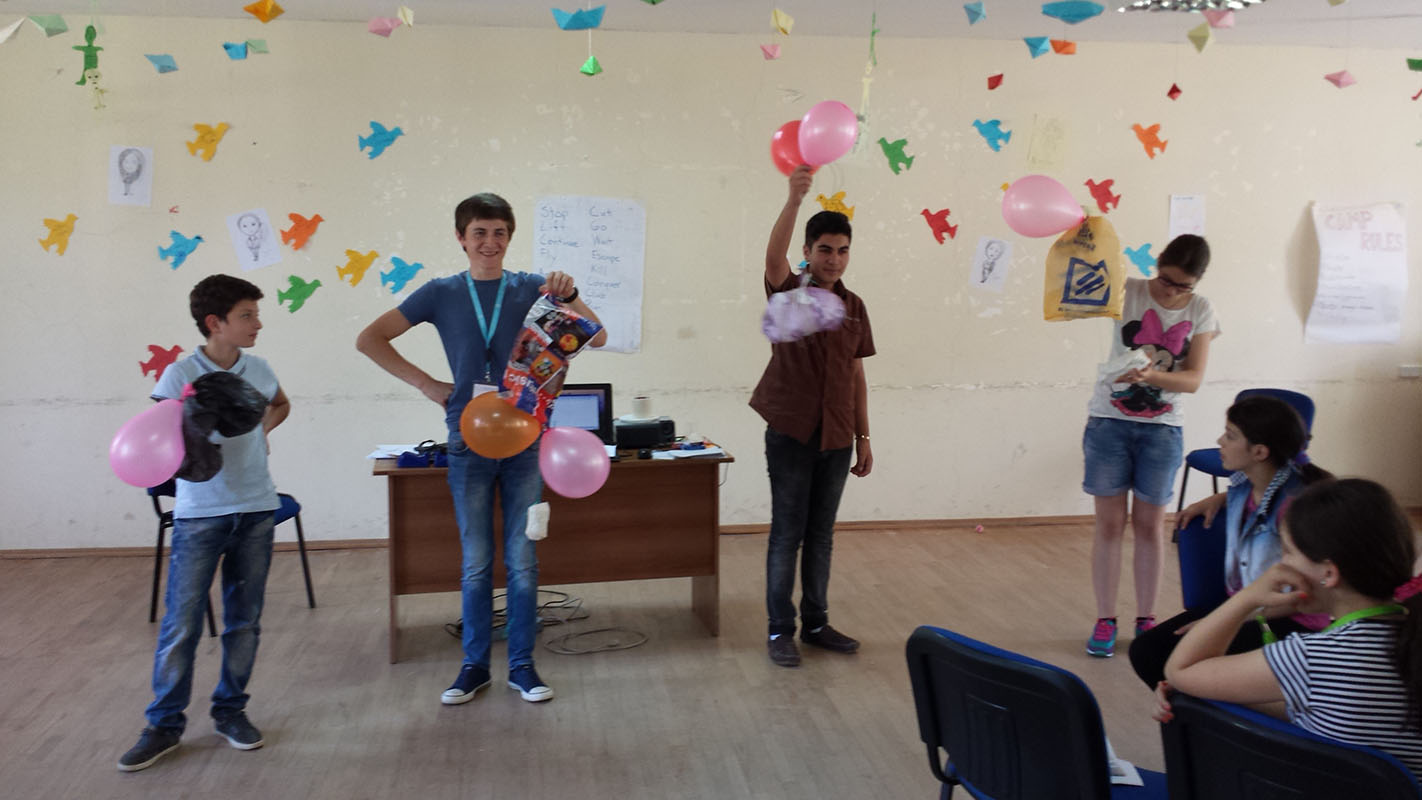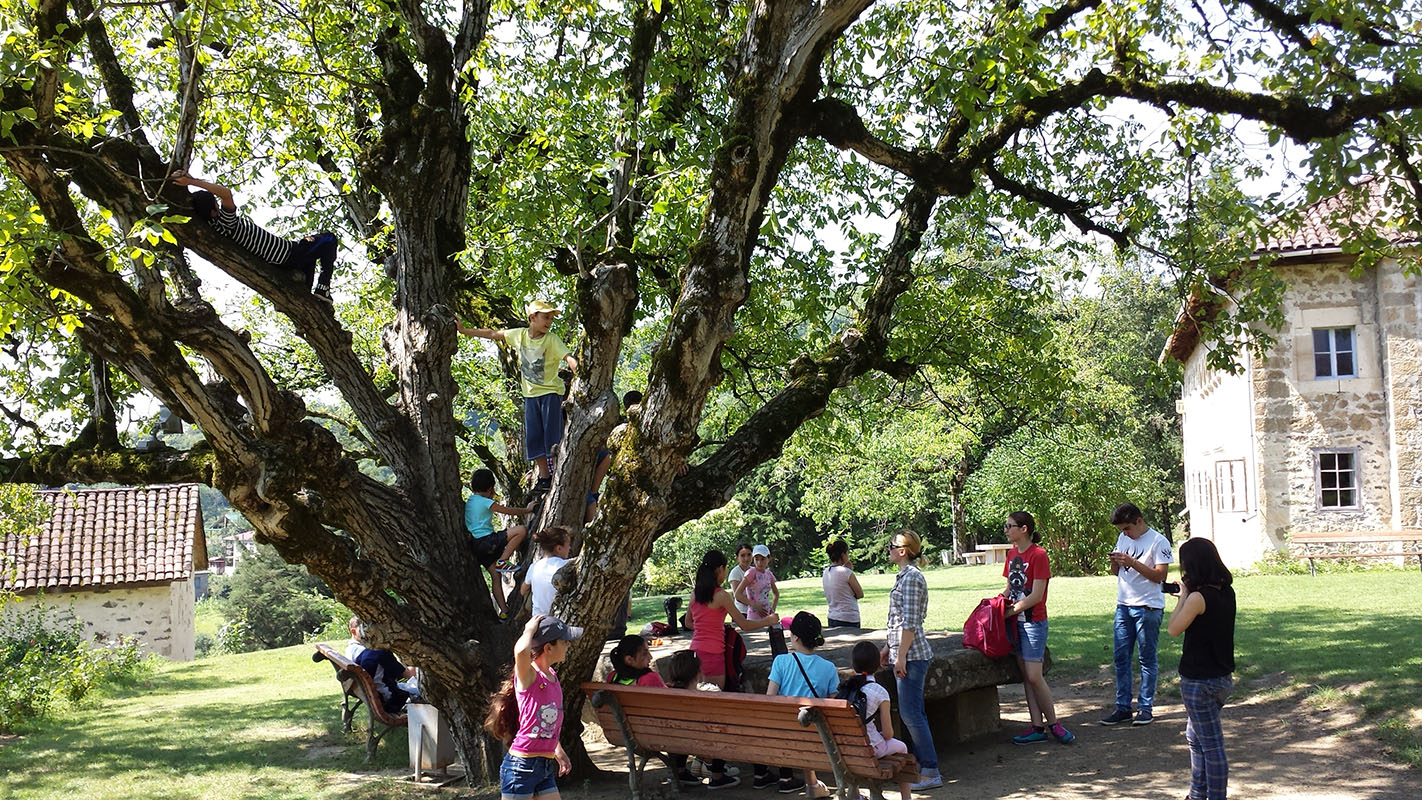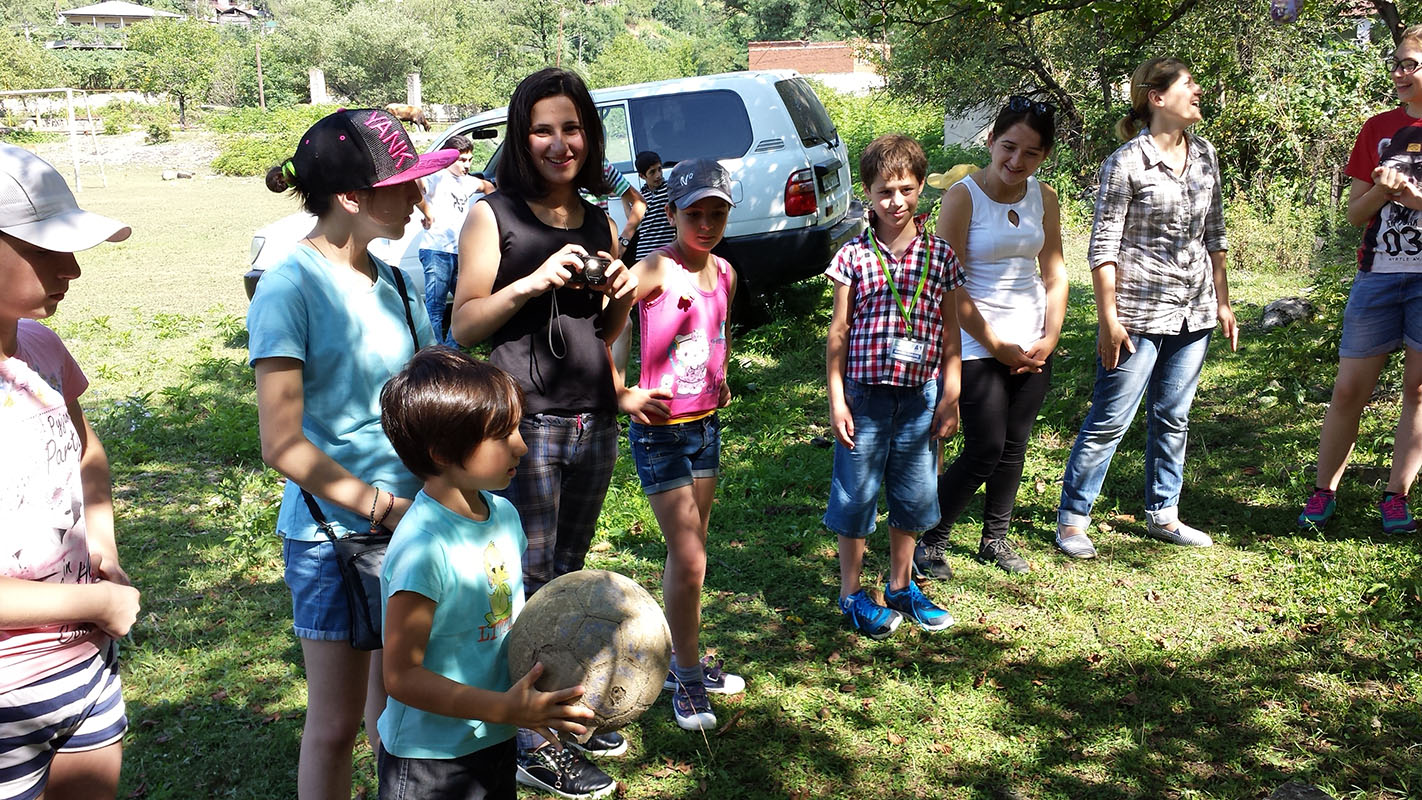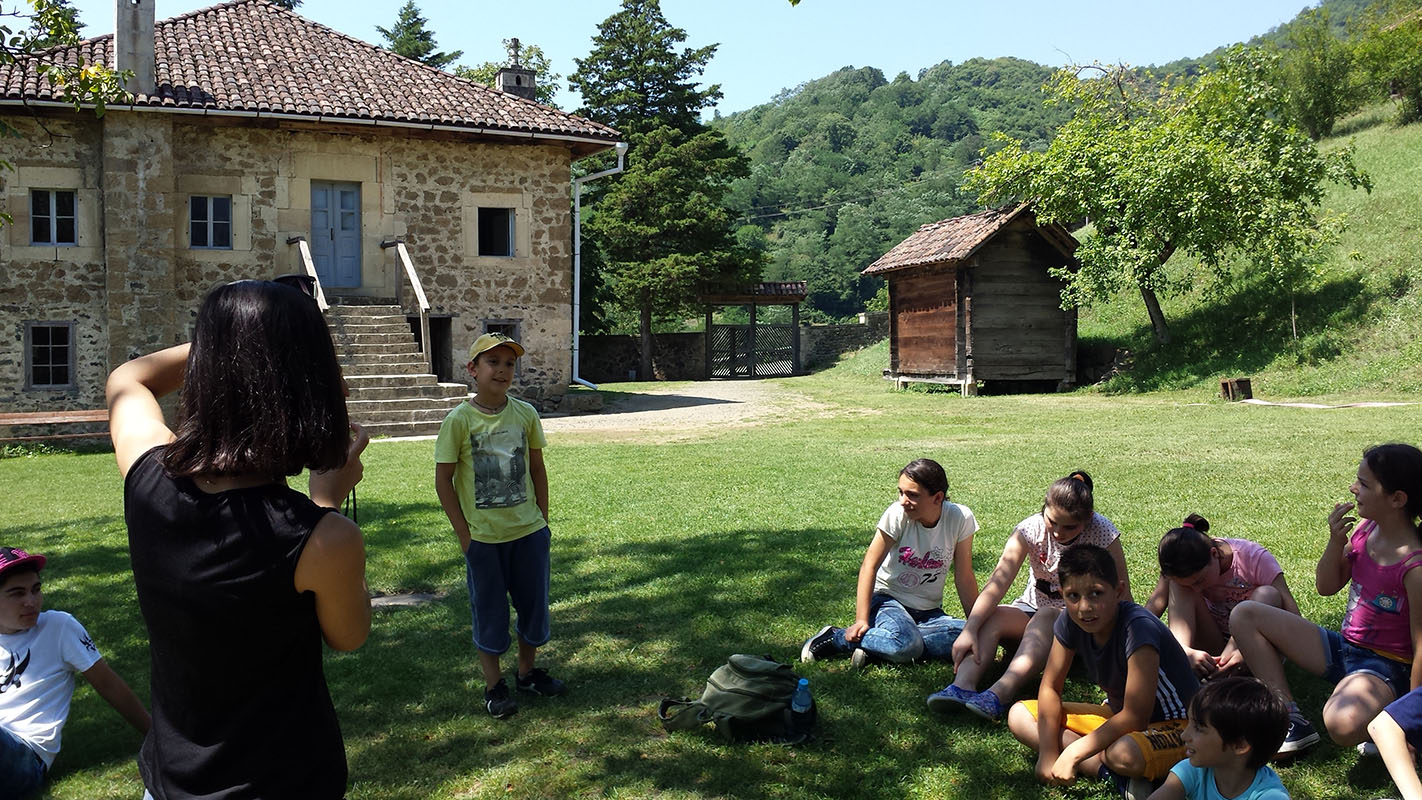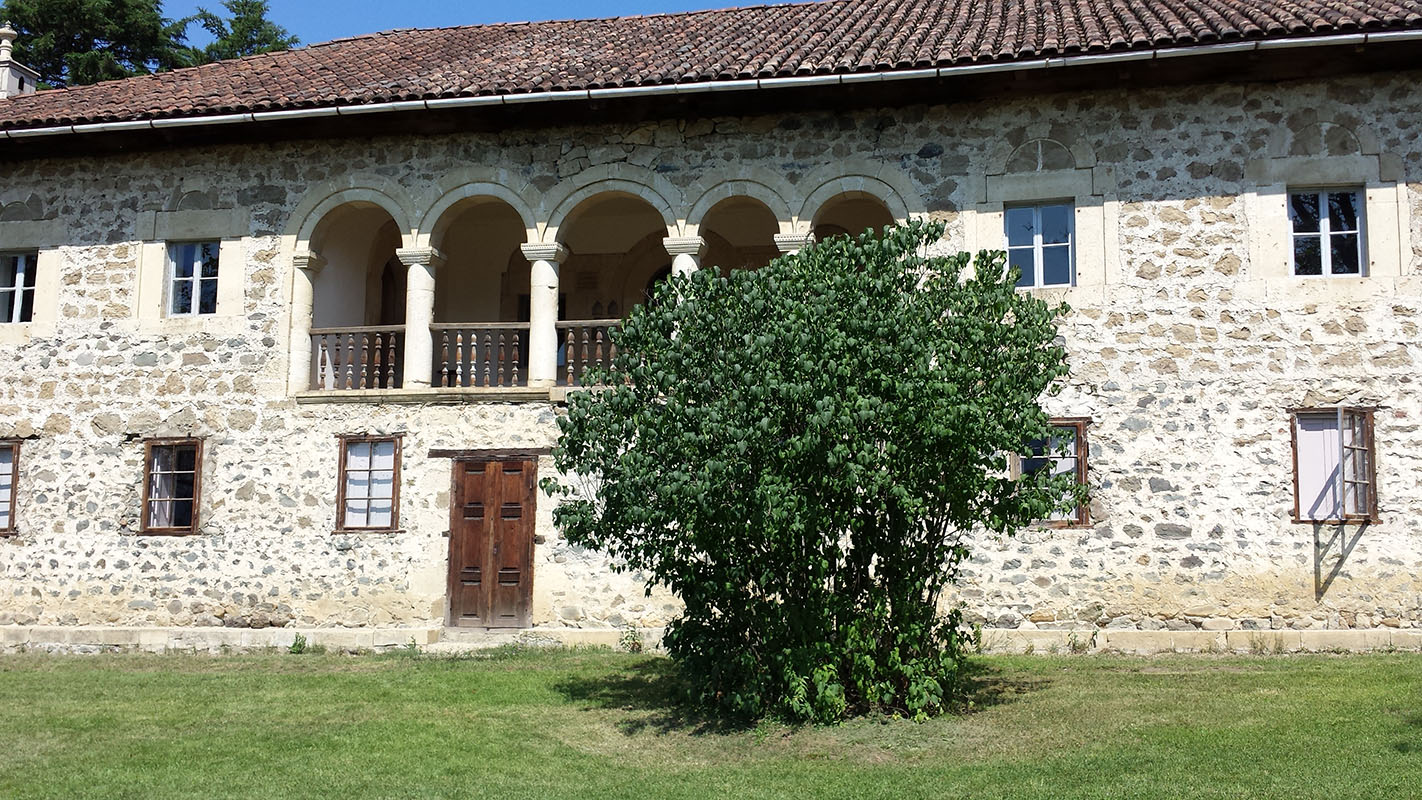Please note that the contents of this website are mine personally and do not reflect any position of the U.S. Government or the Peace Corps.
TL;DR - It was awesome. And yes, this is very long.
Before I say anything about the camp, allow me to say thank you. Thank you to my director and English teacher counterparts, Nino, Nino, and Nino, for believing in me and my crazy idea of "detective camp". Thank you to the many friends who made videos of themselves giving clues, including, but not limited to, Bronwen Callahan, Samantha Gross-Galindo, Andrew Lovely, Shane Freund, Kayla Preston, Sol Ordonez-Duran, Jen Wong, P.K. Royalty and her crew, Melody Jensen, Darlene Ugwa, Elizabeth Cao, and Chris and June Reznic. Thank you to the students who showed up and were actively engaged. Finally, thank you to Brøderbund Software for creating Where in the World is Carmen Sandiego, which was a big influence on this camp.
I am going to try to refrain from naming people in the text as I go. If I get side tracked by talking about all the moments and the people that brought them to fruition, I won't stop. Needless to say, all the people that made this possible are great. Where its true that you learn the names of the trouble makers first, there were several fantastic students across all age levels and genders, including some students from other schools whom I wish we could transfer here.
Note: I don't have a lot of pictures as I was running most activities or prepping for the next one, but there's some of Facebook if you look and I may add more as I find them.
The Detective Meta-Game
Let's start with the most obvious issue, "What was Detective Camp and how was it different from other summer camps?" I got this a lot. The whole idea of "detective camp" was just alien to most people.
Like other Peace Corps camps, students participated in a myriad selection of activities designed to help their English reading, listening, and speaking skills, their English vocabulary, critical thinking, and even some leadership and empowerment thrown in. It also taught and tested knowledge of geography and history. Unlike other camps, it did this by setting up an overall detective setting wherein each day had a particular theme. Day one was "detective training", and days two through four each had a crime to solve.
The crimes were key. Each day something strange and impossible was stolen. Each activity was tied to the country or the crime, letting us walk through an investigative story of sorts for each day. More important to the students, each activity awarded clues that would tell them where the villain was and who they were. "Winning" an activity gave a better clue than "losing", but everyone still got clues (e.g. some students would get that the villain had blue eyes where others would get that the villain didn't have brown eyes). Plus there were bonus clues for individual performance if students helped each other out, gave another kid the spotlight, or shared their school supplies. There was no need to keep track of which team was winning the day or even the camp as a whole. In fact, by the third day, the original teams had disintegrated and students were largely working together to figure things out even though they still competed against each other in activities. Where things started as individual or team efforts, by then end the detective meta-game became a more collaborative experience.
Clue Format
Just giving students clues written on a paper or verbally telling them the clues is one thing, and it certainly would have been faster and easier. However, I decided that video was the way to go. That long list of people up above are those that filmed close to 50 videos for this project. Most of them were pretty short, no more than 15 seconds, but they engaged the students in a way that written clues couldn't have. They also exposed the students to a number of different English speakers of a variety of genders and ethnicities in positive roles, which I certainly couldn't have done on my own (at least not without several changes of clothes and a lot of make up). So where I could have done the camp without those clues, the camp was greatly enhanced by having them, technical glitches and all.
Written clues still work well for some situations, such as hiding a clue on the back of a piece of paper you slip into a mural. It all depends on what activities you run.
In addition to clue videos, each day was book-ended by a video of someone telling the students what was stolen and that only they could help and a second video [potentially] thanking them for a job well done. After the intro video I would give them some information as to why the stolen object is so important as well as some information about the country it was stolen from. This gave them some knowledge that would be used in the activities of that day.
On the whole, this worked well. Unfortunately, we couldn't get the projector to work. So I was relying on my laptop and smart phone for clue distribution. That worked well enough except when some clues were too quiet. One big take away, only give out two sets of clues after each activity. Otherwise you will lose too much time between activities and thus student attention.
Where I gave a list of instructions to my video stars, I would probably revise the instructions to look something like this.
- Speak clearly - If I can't understand you, the students won't. This wasn't a problem.
- Speak loudly / Record at a loud volume - If I can't hear you, the students won't. This was a problem for about half the videos.
- Do not use slang or swear words - Let's make sure they understand the basics. This wasn't a problem.
- Identify yourself and your source (e.g. Agent Frankfurter here, I heard from my sources that...) - Letting the kids know who you are and how you got it makes it seem more real. No problems here, and some were really creative.
- Stick with one identity - If you are changing you identity between videos it could cause confusion. However, in practice, it didn't matter much. Most students either didn't remember what the clue givers called themselves or didn't care.
- Don't name yourself after villains - It may confuse the students. This video was a little quiet so kids missed the name.
- Don't combine clues - This only happened once or twice and wasn't a big deal, but I can be a bit of a control freak. It just changed up how I awarded the video, but had there been more it may have been an issue.
- Have fun - If you are clearly enjoying yourself rather than just reading a script, then the students will pick up and reciprocate. The difference between videos with people having fun and others was like night and day. This was only an issue for a couple of early videos, ones made before I started adding this instruction.
Location Clues
When planning your clues, you can never have or give too many location clues. Location clues aren't just about leading the students to the loot; they are about educating students on the geography and history of where the loot is. For instance, clues for Japan included "is in an island nation", "going to a country that wasn't conquered by the Mongols", "going to a country that uses multiple alphabets", "wants to learn about Buddhism", "wants to learn Origami, the art of folding paper", and several more. If by the second clue most kid have figured out the villain is in Japan, great, keep giving them clues because this is your chance to educate them about Japan.
When giving out the location clues, I started broad and slowly narrowed it all down. So the first clues were about the continent, then the country, and then the city/natural feature (e.g. Grand Canyon). Finally, I would give them information about specific buildings in the city, but unless they have smart phones and internet, you should only require them to know the city or natural feature.
In retrospect, I would have liked to give out even more location clues. At first I viewed them just as a way to lead students, and I assumed they would use smart phones (kids in Gori would for other stuff) just like I used an almanac when I played Where in the World is Carmen Sandiego. As I saw things in action, I realized more and more that the location clues were really all about teaching the students geography and history.
Beyond the clues that you might distribute as prizes, it is also very important to prime the students. Going into a camp you may not know what their knowledge base is. So you want them to know the locations you will use. This is where Day 1 comes into play. Many of the activities stated and restated the names of countries and cities that would come up later on. For instance, "Find Someone Who" asked for people who had been to Peru. Although I was 99% certain no one had been to Peru, I wanted them to start thinking about it. Similarly, during "Photo Scavenger Hunt", there were items like "someone pointing to Peru on a map" and "an origami crane". Repetition of these things primes the students and starts them thinking about those locations.
Villains
Of course, to make all of this work, we needed a Rogue's Gallery. Carmen Sandiego was honored with the top spot. People may also recognize Doctor Claw from Inspector Gadget and Miss Scarlet from Clue. Lucille Vox was a nod to Lucille la Verne who voiced the Evil Queen in Disney's Snow White and the Seven Dwarves, and Natasha Batenov was a nod to Natasha Fatale and Boris Batenov of Rocky and Bullwinkle fame. Rounding out the cast were Canadian Ice, Candle[stick] Jack (named after a nursery rhyme), Captain Medeva, Dishonest John (from Beany and Cecil), Milo Valentine, Professor Burgundy, Silas Greenback (from Danger Mouse), and The Surgeon (who came to be my favorite).
All of the villains (except Carmen) had a listed gender, hair and eye color, and two additional features that students could use to identify them. The males had one set of special features and the females had another. This allows for overlap so one clue won't give the villain away. It usually takes 3 to 5 to determine the villain. Let me say, there is great satisfaction in watching the students run from where you gave them the clue to the villain board to narrow the choices down. This happened almost every time I gave out a suspect clue. The exception being when I awarded one student on the side and she then quietly snuck up to the board so as to not draw attention. Well played.
So, the overview given, let's walk through each day and each activity. We'll also take a look at what worked and what didn't. Consider it helpful advice to fellow Peace Corps Volunteers who want to run similar activities or even their own camps.
Day 1 - Detective Training
Camp Rules. Numbers 6 and 7 were added after day 1, and rule 3 had to be continually stressed.
Activity 1.1 - Sign-In (20m) - Kids sign in, all good. Have an activity for them to do during this period after they have signed in. Frisbee is a good one if you have gym or outdoor space. On subsequent days, our five finger feedback filled this niche.
Activity 1.15 - Not an official activity, but we had an introduction of each of us, the rules, the nomination process, the schedule, etc. Really, it was part of sign in. Its necessary. Don't forget it!
Activity 1.2 - Group Formation & Identity - We purposefully mixed the older students and the younger students so there was a mix of ability in each group. The idea being that the older would mentor the younger (and this was made an explicit rule on Day 2 after some students failed to do it on Day 1). On subsequent days, after the expectation was made clear, this worked really well.
Group identity was done by them naming their team, choosing slogans, and choosing a symbol for their badges. They then presented these and themselves to the rest. In theory good, and the groups held through Day 2. Slogans came up later on day 1, but symbols never did. The lesson here is that where this may be a fun activity, it is enhanced by integrating the products throughout the whole camp. For instance, when we did a camp in Gori, we had them make team posters and then we drew badges on the posters to mark success in events.
Activity 1.3 - Find Someone Who - Sixty descriptors split across three lists gave students lots of people they needed to find. It worked out good overall, and we started priming students to think about the three countries where villains would take their loot by incorporating them. The big "what would I do differently" is that I would just assume all the answers that groups got were right, and I would only ask about a few of them, like the country questions, who could recite one of Akaki's poems (and ask them to do it for an extra point), and the like. Asking about every question takes too much time and can be boring for students.
Activity 1.4 - World Map & Poster - Given that this took prep we hadn't had time to do yet, we switched this with Photo-Scavenger Hunt. Lesson: Keep a flexible. Seriously, so many things can and will go wrong, that you need to be able to adapt on the fly. This is just the first example from this camp. I think we shuffled the agenda every day.
During break I drew a map of the world on the ground outside with chalk. It looked poor (I apologize to our planet for my drawing), but it got the job done. Students then picked a country they wanted to travel to and say why. Many European nations were chosen, mainly Italy, which was good for us. Unfortunately no one chose Peru or Japan. Many students did not participate because it was outside, and it was warm (to me, to everyone else it was too hot). Instead they huddled in the shade. Lesson: When its hot, outside sucks unless its a water game. If I did this again, I'd probably just have a wall map and have students come up one group at a time and point to the country or sketch it out on the floor inside using twine (see day three for the price on twine).
Next, we went back inside and, based on what people had said about countries they wanted to visit, we had the groups make posters about different countries. We had hoped that the repetition of Peru, Italy, and Japan would lead teams to choose those. Where there was some talk of Japan, it wasn't chosen. Neither was Peru, but at least Italy was. Interestingly, so was India. The students had to present their poster and their country, which was a good opportunity for them to educate each other.
Activity 1.5 - Break - cue the elevator music - time used to set up next activity
Activity 1.6 - Photo-Scavenger Hunt - Switched with 1.4 so it actually took place before break. This required digital cameras and running shoes. It got the students running all over the place as they tried to photograph items on the list. Some items required cooperation. Others required some knowledge of other cultures. Some were just fun (e.g. someone eating). Like Find Someone Who before it, it was intended to help prime the students with some hints they could use later (e.g. an origami crane or someone pointing to Japan on a map). Many were in the theme of detectives and crimes (e.g. someone hiding in shadows, someone wearing a mask, etc.). On the whole it went well. We didn't expect any group to get all 40, but we wanted to make sure they wouldn't run out of things to photo. We also jumbled up the order of those 40 items, making three lists. This helped prevent students from all going for the same thing at the same time.
Activity 1.7 - What Do I Know About Sachkhere? - Full credit for this one goes to my director. It gave students clues as to where to find people who would ask questions about Sachkhere. If you were right, you got a stamp/sticker. It worked really well. Students need a time limit though, and as with most games we ran, it really helps to give the groups lists that are in different order so they don't all follow each other.
Five Finger Feedback model.
Activity 1.8 - Wrap Up and Feedback - In practice, the feedback was shifted to the next morning during sign-in. Wrap up was a simple recap. For the feedback they drew a hand and labeled parts of it. The palm was a message to the instructors, the thumb is what was OK, etc. Yes, we read all of these. Yes, we adapted some things because of this feedback. Some things we did in response to feedback we explicitly told the students we did it because of what they said.
Day 2 - Crime in Paris
Activity 2.1 - Sign-In (and Feedback) - Same as 1.1 with the addition of feedback from 1.8.
Activity 2.2 - Introduction - The plan was to introduce the students to the first crime by playing a video with speakers and projector. Well, the computer worked, and so we made due. The Eiffel Tower was stolen! The police are baffled and only you can find it! This was accompanied by a little history on the tower and a bit of information about France
Activity 2.3 - Me Minda (what was found at the scene of the crime) - Me Minda means "I want" in Georgian. This got switched with Wind Blows because supplies had not arrived yet. When we ran it, it worked out well. It was intended to introduce the objects that would later be used with Useless Objects. Wind Blows made for a better intro game anyhow. For those that don't know, this game works by giving each group an identical set of objects. Faculty in the middle says "I want" then the object. A group member must pick up the object and run it to the faculty member. Most kids love it, and it works well to drill limited vocabulary.
Given the different age groups, we had a rule that the same student couldn't run twice in a row. This is where the older kids stepped up to organize who was running what objects to try and maximize their chance.
Suggestion, mark where the groups have to start running from. They WILL creep forward, and they WILL complain that other groups are closer as justification. Masking tape on the floor gives an easy mark you can reference.
Amusing aside, when discussing the game with my director before hand there was a moment where we were brainstorming objects that would work with both Me Minda and Worthless Objects. She grabbed a pair of scissors and said how about this. A moment of reflection, a raised eyebrow, and a question about kids running with scissors later she said, "right, maybe not". We all got a good laugh.
Activity 2.4 - Two Truths and One Lie (interviewing suspects) - This activity ran into problems almost right away. We gave each group a sheet of facts about the criminals and France (e.g. who Joan of Arc and Napoleon were, etc.), and a volunteer from each group was supposed to go to the next group over and read two truths from the sheet and make up one lie. That group was supposed to guess the lie. So we would practice English and learn some French history. Some groups didn't understand. One group ran off to check the statements about the villains to see if there were any clues, and most groups went out of order. In short, it was a mess, but it sort of worked itself out. Yes, this activity is a bit complex, but so is 20 Questions, which we ran on day 4.
Learning from this experience, changes were made in how to introduce the the activity, which made 20 Questions run very smoothly. Start by asking for volunteers, and have them come up to the front of the room. Keep them there while you explain AND demonstrate the activity. If there are no questions, only then turn them loose, and when you do, tell them exactly what group they need to go to. When they finish with one group, have the volunteer report the results before going to the next group.
Activity 2.5 - Crossword (seeing how the clues fit together) - Using each of the statements from 2 truths and 1 lie I did a Google search for free crossword puzzle creators, input a series of clues and answers, and just kept hitting reload until I got a puzzle that used the most. The one I settled on used all but one of the answers I input. Fittingly, that one was also the villain for the day, which I thought was a great way to give a clue, if rather difficult. Of course, we also split the clues in half. So no one group could fill in the puzzle on their own. It worked well since all the answers were on the sheet the groups were given in 2.4. So if a student asked us about a question, we could help them find the answer in the text.
What would I do differently? Probably make it two smaller crossword puzzles instead. Smaller means less daunting and thus easier.
Activity 2.6 - Wind Blows (travel) - This was moved to the first activity, and it worked out better there anyhow. Narration wise, I sold it as representing their trip to Paris to investigate the crime. Everyone sits in a chair and then a volunteer says "the wind blows for..." and then names something like "people wearing shorts" or "people with black hair". Those people have to find a new seat and compete with the person in the middle too. The one without a seat is the new person in the middle. This went amazingly well. In fact, on day five, one of the girls wanted to play it again (though we didn't have chairs on the play field!). What would I change? I'd just plan for it to be the first activity in the narrative.
Activity 2.7 - Break! - Dance like you mean it, and set up for the next activity.
Activity 2.8 - Fun Questions (reviewing facts learned so far) - The way this is supposed to work is you put post-it notes on the walls and play music, when the music stops the students must grab a question and answer it. Well... chairs were up against the walls and would get in the way, and we didn't have the music player (I'd rather not blow out my computer's speakers). So, time to change it up!
Taking the 30+ questions I put on post-its I arranged them in a snowflake or sunburst pattern in the middle of the room. From each of the rays I counted about 3 meters and put a marker with masking tape. On "go!" one student had to run over, grab a clue and run back where the group tried to answer it. They write down their answer and raise it above their head before 1 minute was up.
Dang, this worked well. The questions were a big mix, everything from "what do the French celebrate on July 14th?" to "who is the leader of the Autobots?" to "what is your team name?" to "who sang in class yesterday?". When the students discovered the variety in the questions, some started taking their time to choose an easy one before running back with it. I was really worried about how well this activity would fit in and work as written, but as modified it worked wonderfully.
As a bonus, some post-its had "bonus clue" on the back, which meant I gave the group that grabbed that one a bonus clue.
Activity 2.9 - Worthless Objects (reflecting about items at the scene of the crime) - Due to time constraints (we were running over by quite a bit), this activity got nixed. The plan was to describe how each of the objects from Me Minda was found at the crime scene. Each group would have to choose a different object. They would then have to make one argument per group member as to why that was the most important object at the scene. It was intended as an intro to debate. I was sorry to see it go, but parts of it were used in activities on days 3 and 4.
The one group that mostly followed instructions.
Activity 2.10 - Sum of Parts Mural (checking out the Louvre) - So... this went bonkers bad. Part of the problem is students not understanding instructions, and, in some cases, not even listening to them. Another part was all of the instructions being given at once. There may also be issue with my inflexibility in letting the students run amok. =)
The way it is supposed to work is every student gets a piece of paper that is a funny cut out shape. They then draw on it whatever they feel like. Make it into a face, draw a garden, all good. When you are done, go get another piece of paper and repeat. Continue until time is up. Then each group would put their pieces in a pile and another group would assemble them in any way they saw fit, making a collaborative mural (and a chance for me to sneak in clues). Instead students were just grabbing all the paper and assembling it all within the group.
How do we fix this? Just change the instructions. The students are smart; I just need to package it better. In the future, I would start the exercise as individual art projects and hand the students their starting paper after giving them their initial instructions. Only after the drawing time was up would I put them back into groups and explain how the mural would get assembled. I may also just do one big mural on a bed sheet rather than a smaller one for each group on poster sized paper. That would hopefully help address some issues.
Activity 2.11 - Wrap-Up and Feedback - One team (Teen Detectives) successfully figured out that Milo Valentine stole the Eiffel Tower, and another team (Nightmares) had figured out that he was in an old Roman temple in Rome (but lacking internet couldn't look up the exact answer, which is ok). So together they were able to help police put our villain behind bars!
Day 3 - In the Jungles of Thailand
Activity 3.1 - Sign-In - See 2.1 above
Activity 3.2 - Introduction - The Three Kings Statue was stolen from Chiang Mai! Good thing we have some detectives on the case!
Just as important as the fun stuff, we reviewed the feedback and many students complained that things were too noisy the previous, something us faculty also noticed. So when we reviewed the camp rules we were able to stress that this was an issue that affected everyone. The change in behavior this day was very noticeable especially after break.
We also started more stringently enforcing the rules, which could change the results of some activities as a team forfeits due to one member's bad behavior.
One of the four volunteers, Giorgi, getting rescued by a mob. He didn't want to go. So they had to drag him!
Activity 3.3 - Shipwreck / Polar Bears (travel) - The ship they were taking to Thailand was sabotaged! Four made it to shore and must rescue the others! This is a cooperative energizer wherein two people must go arm in arm into the "water" and scoop up a third person between them to save them. Rescued people can form up to save more people. It goes quick.
Then those four were so exhausted that they needed to be rescued. This time, all the other students had to form a human chain to pull them in. Of course, this degenerated with hilarious results.
The "winner" was the group of the last person rescued. We told them that the winner would be based on who got their team rescued first, but we didn't say how. The idea here was that putting the safety and well being of others ahead of a "team win" was what really mattered. Adjustments? Nah. It was fast and fun.
Nino helping with pronunciation during the presentation of Stranded.
Activity 3.4 - Stranded in the Jungle (what did you save?) - Each group (we reassembled the 6 groups into 4 due to lower turn out) had to pick 5 items that they would have saved from the ship wreck to help them survive in the jungle and provide an argument for why each one would help them survive. In practice this became 1 item for each person, which was OK (and what we were going to do for day 4). This is a variation of Worthless Objects, something of a "light" version, but it worked well with the spread in age and skill.
I wouldn't change anything to this activity. The students didn't know the vocabulary for all the items (e.g. machete), but they would ask, which was great.
The best answer: "Toilet Paper, no explanation necessary."
Activity 3.5 - Noises in the Jungle (what you hear while in the jungle) - IIRC, we moved this so it was later since we didn't have the print outs at the time. For this, take a dialog (or in our case three songs from The Jungle Book) and separate the text so one page only has half the verses and the other page has the other half. Students then have to speak their text to their partner, who has to write down what they hear, and vice versa. It worked out well, and two students identified where the text came from. Nothing major went wrong with this, but students often tried to just copy each other's sheet. In retrospect, that is probably fine for students of lower skill, but they should still try to speak and listen.
Activity 3.6 - Obstacle Course (getting out of the jungle) - Arriving at school before anyone else and armed with a roll of twine (4 lari for 650 meters, I couldn't believe that price!), some tape, and five plastic plates, I co-oped chairs from one of the class rooms and built an obstacle course in the hall of the 3rd floor to the amazement of the students (and my counterparts). The plates were poisonous mushrooms, the twine was spider webs that would alert giant spiders, and the chairs were slick rocks. I built it to give the smaller kids the advantage, but it still proved too much. No one could get through the first time. On the second time through they could use the chairs and about half made it. It proved great for problem solving, and the students really enjoyed it. You can make this sort of course out of almost anything too, which is great.
Activity 3.7 - Break - The final activities proved quite productive this day.
Lining up for Night Orienteering.
Activity 3.8 - Night Orienteering (chasing suspects at night in Bangkok) - We moved this to the last activity. Using only English, two groups had to direct one blind folded member across the room, around a chair, and back. I made it so the two paths crossed (only one collision), and, after the blindfold went on, I would add chairs as obstacles. It worked really well, and I didn't mind the groups following their teammate shouting directions, so long as they were using English.
Activity 3.9 - What I saw (finding clues in surveillance photos) - Due to the lack of a functioning projector, this was cut. The way it was supposed to work is that we would show the students a series of pictures (of Thailand). Each picture would only be shown for a short time, and the time would get shorter for subsequent pictures and/or the pictures would get subsequently more complex. After each picture was shown, students would write down as many things as they could remember and then, as a group, try to redraw the picture.
In theory, this is a great way to show students other cultures and practice vocabulary. Unfortunately, you need a projector to really make it work with digital images.
Passing rumors in Telephone.
Activity 3.10 - Telephone (chasing rumors) - Space was taped off for 4 groups (we worked it down to 3). The tape showed where each student of the group should stand. Those in the center were given ten sentences that were either facts about Thailand or lines from Noises in the Jungle. We went through most as they whispered the sentences down the line and tried to cheat when they thought I wasn't looking, which made for some funny moments. If anything, I would have liked to do this activity earlier to get the geography/history out there sooner; however, our "jungle cruise" prevented that.
Activity 3.11 - Wrap up and Reflection - The detectives successfully tracked Lucille Vox to Lima, Peru. They knew she was in an old palace used as a government building, which was enough. Without internet to look up more than that, I was just happy when they came up with Lima. South America isn't well known here.
Day 4 - Stealing America
Activity 4.1 - Sign-In - See Activity 3.1
Activity 4.2 - Introduction - The torch from the Statue of Liberty was stolen! We need help to get it back!
Activity 4.3 - I'm Going to America (packing your bags) - This was essentially Stranded (Activity 3.4), except with a different focus: What do you pack when you are travelling to America to investigate a crime. This time we just said that each person in a group had to choose a different object and justify it. It went just as well. Amusingly, one of them said they'd bring me for my English skills.
Considering the teams only had 10-15 minutes to come up with their skits, they all did quite well.
Activity 4.4 - Situation Game (reenacting the crime) - We asked students for a series of verbs that they thought could describe the crime. Once we had a list of 12, including Conquer (which they learned from Rome with respect to Europe and Africa, Napoleon with respect to Europe, and then the Spanish Empire with respect to Peru), the four groups then had 10 minutes to create a skit, using as many of the verbs as possible, that showed how the thief could have stolen the torch. This went surprisingly well (and violently), and a couple of the students showed real acting talent.
What would I change? I may require more speaking. Most of the skits were silent with explanations after. Those that used more English during the skit got extra points. On the whole though, it went really well, even if it was an awkward time to discover that no one knew what the English words "skit" and "play" meant in this context, which made for an interesting sidebar.
Activity 4.5 - Twenty Questions (Interrogating suspects) - Due to time overrun and how Two Truths and One Lie went, I wanted to drop this one, even though it helped familiarize students with various figures, holidays and places in USA. It was shuffled to the afternoon as a maybe. Then break ran long, students were restless, and I was alone with them. Well, let's make this work. Since Two Truths and One Lie was such a mess, I simply reviewed what went well and what didn't and changed how the instructions were given in a manner described above (2.4). And... it worked! Most of the way through the directions, my counterparts arrived to help with the translations, but this genuinely worked. So don't doubt your students' ability to handle something complex. You just have to find a new approach to explaining it.
Each group had a list of the things the suspect (volunteers) could be, and each member of a group could ask one question. By the end they had to guess it. The suspects had another sheet (two really), with a short paragraph about each possible subject. About half of the time the groups got the right answer.
Activity 4.6 - Letter Mix Up (mapping your way through the city) - This was not the Letter Mix Up you read about in a TEFL manual. This was hijacked from computer games and Indiana Jones and the Last Crusade. I took the vocabulary for Activity 4.8 and designed grids that students would have to walk across. There were three grids planned in all, each successively harder, and the third one would actually use vocab from Twenty-Questions. There was a problem though: Labor. It took an hour and a half to build the first and second grids out of tape. I had wanted to have two sets of grids so multiple students could go at the same time.
What was important to this was that students could help each other. Plus, I had the students with better English go first. That way the younger students could see the pathways and the spelling. The repetition of words and watching each other spell them out helped drill the words in. That this was done with physical activity helped target students with different learning styles.
What would I change? I'd go with my first choice of using chalk, even if it meant having to constantly redraw some letters and having to mop it up myself (outside in this heat kids would not be active). The tape was durable to being stepped on, but it was very labor intensive to set up.
Activity 4.7 - Break - Seemed a bit long this time, but then I also spent 5 minutes of it pulling up tape with three of the student (thanks for helping guys!)...
Activity 4.8 - Egg Drop (we now know the torch was cut and dropped, how could it have survived the fall?) - I am always amazed at how well this one works. Its complex, but students really get into it. Its just amazing fun and really works their critical thinking skills. The only down side is that I don't have a picture from outside of the four groups simultaneously dropping their egg cradling contraptions. Also, three of four survived.
Only changes I might make is different materials and/or smaller groups. The materials themselves were fine, but I would probably offer a few different "packages" and the teams would have to choose which one they wanted. One might have 10 balloons where another might have cotton. Smaller groups also helps make sure that everyone gets involved. It wasn't too much of an issue, but there were moments.
Activity 4.9 - Capture the Flag (chasing down suspects) - Standard Capture the Flag with two twists. First, if you get tagged, to get out of jail you need to answer a question in English, which could test your knowledge of the week or just be "what color are your eyes?" depending on the student's skill level. Second, each capture gets you a clue. That last part proved to be good motivation.
Activity 4.10 - Wrap-Up - The students correctly identified that the villain was going to Japan, and they knew he was hiding on a mountain, but they couldn't remember Mt. Fuji, which had been named a few times in the week. They also didn't quite have enough clues for the suspect (the student with an important clue went home while this was under discussion and failed to share beforehand), so they had to guess between Silas Greenback and Dishonest John. They chose poorly.
Where the other days went very well with the location clues, this is the day that made me re-examine how to treat location clues. So if I did things again, I'd make even more location clues and give them out much more often.
Day 5 - Excursion
The last day was slated to be an excursion of the students' choice. They wrote suggestions, and so we wound up walking to Akaki's Museum/Home; though, initially we stopped at the field nearby to do some games, which didn't last long due to the heat.
The students had also submitted nominations for certificates (e.g. most supportive, most communicative, best memory, etc.). These certificates were awarded on this day as well. Unfortunately, I don't have a master list of who got what, otherwise I'd share.
The overall theme for this day was student empowerment. They got to make most of the decisions regarding where we went, what we did, and who got honored. These students will one day be leaders in their communities. So its good to treat them like that now and then.
Well, that's a wrap! Where it may have been my idea that kicked this off, it could not have been done without the support of my director and counterparts. It wouldn't have been as awesome without friends from four countries and three continents making clue videos. Most of all, it could not have been a success without the students that showed up each day with enthusiasm to learn and have fun. We crammed a lot of knowledge into a short span of time. I just hope some of it sticks =)
Filmed by and staring Bronwen as Carmen Sandiego. She gives the students of Sachkhere's Detective Camp a farewell message.



